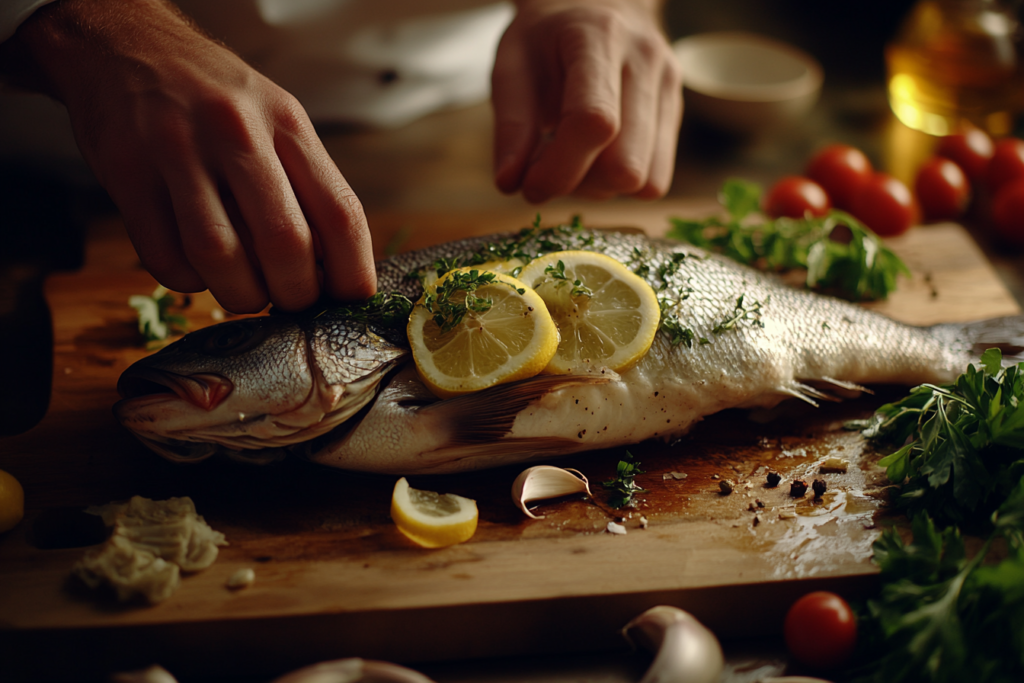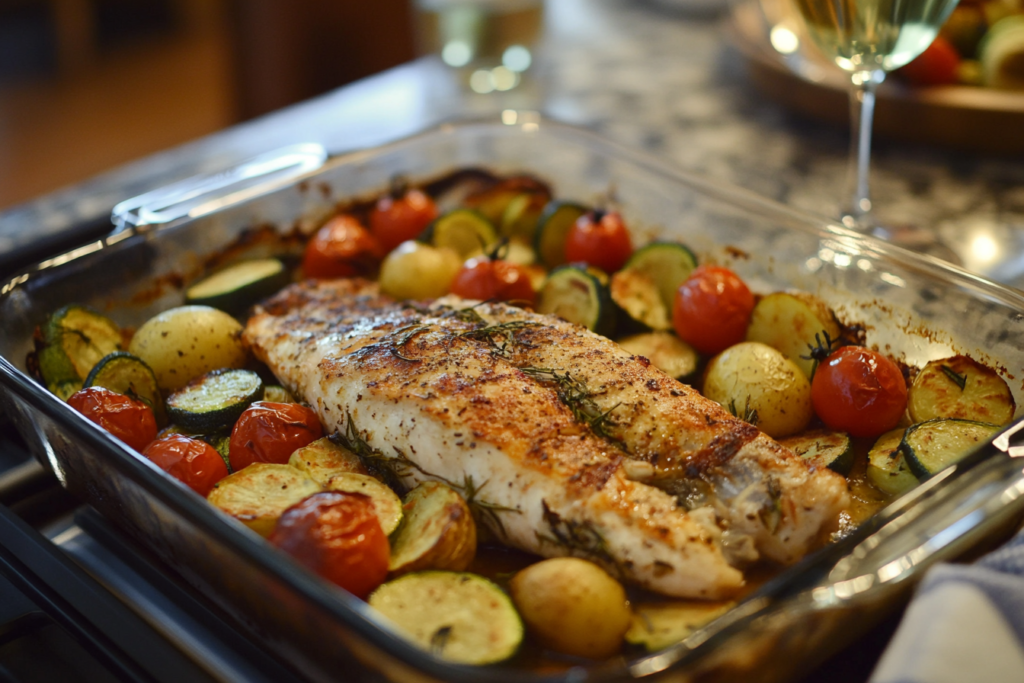Table of contents
What is Branzino and Why Is It a Good Fish to Eat?
Branzino, also known as European sea bass, thrives in the Mediterranean Sea and the eastern Atlantic Ocean. People prize it for its delicate, mild flavor and flaky white flesh, making it a favorite in Mediterranean cuisine. Chefs often serve branzino whole, grill it, bake it, or steam it, showcasing its versatility in various culinary traditions.
Origin and Classification of Branzino Fish
Branzino belongs to the Moronidae family and scientists classify it as Dicentrarchus labrax. This carnivorous fish thrives in coastal waters, lagoons, and estuaries. Calm, shallow waters often provide its natural habitat, but branzino also adapts to environments with low salinity levels, showcasing its versatility.
The fish originated in the Mediterranean region, where it has served as a culinary staple for centuries. Fishermen traditionally catch wild branzino in regions like Italy, Greece, and Spain. Today, aquaculture farms extensively raise branzino to meet the growing global demand.
Common Names for Branzino Across Regions
Branzino is known by various names depending on the region:
- Italy: Branzino or Spigola
- Spain: Lubina
- France: Bar or Loup de Mer
- Portugal: Robalo
- Greece: Lavraki
- Turkey: Levrek
- English-speaking regions: European sea bass
This diversity of names reflects its widespread appeal and central role in many coastal cultures’ cuisines. Whether prepared simply with olive oil and herbs or as part of a complex dish, branzino continues to be a favorite in kitchens worldwide.
Health Benefits of Eating Branzino Fish
Branzino is not only delicious but also highly nutritious, offering several health benefits that make it a valuable addition to a balanced diet. Its rich nutrient profile supports heart health, brain function, and overall well-being.
Cardiovascular Benefits of Branzino
Eating branzino regularly can significantly contribute to heart health. It is a lean source of protein and contains low levels of saturated fats, which are associated with improved cardiovascular function. Additionally, branzino is rich in essential minerals like potassium and magnesium, which help regulate blood pressure and support proper heart function. Consuming this fish may reduce the risk of heart disease by promoting healthy cholesterol levels and maintaining blood vessel integrity.
Why Branzino is a Rich Source of Omega-3 Fatty Acids
Branzino is an excellent source of omega-3 fatty acids, specifically eicosapentaenoic acid (EPA) and docosahexaenoic acid (DHA). These nutrients are known for their anti-inflammatory properties and their ability to lower triglyceride levels in the blood. Omega-3 fatty acids also play a critical role in brain health, improving cognitive function and potentially reducing the risk of neurodegenerative diseases.
Moreover, omega-3s found in branzino support joint health, improve skin elasticity, and boost the immune system. Including branzino in your diet provides a natural and flavorful way to meet your omega-3 requirements.
By incorporating branzino into your meals, you not only enjoy its delightful flavor but also benefit from its substantial contributions to a healthy lifestyle.
Culinary Uses of Branzino
Branzino is celebrated in kitchens around the world for its mild, sweet flavor and versatile texture. This fish adapts beautifully to various cooking methods, making it a favorite among professional chefs and home cooks alike.

Popular Cooking Techniques
Branzino is traditionally prepared using methods that highlight its delicate texture and natural taste. Popular cooking techniques include:
- Grilling: Whole branzino is often grilled, typically seasoned with olive oil, salt, and herbs like rosemary or thyme. This method enhances its natural smoky flavor and keeps the flesh moist.
- Baking: Baking branzino, either whole or as fillets, allows for the addition of flavorful accompaniments like lemon, garlic, and fresh vegetables.
- Steaming: A gentle cooking method that retains the fish’s tenderness and natural nutrients, steaming is often paired with light sauces or simple seasonings.
- Pan-Seared: Fillets of branzino can be pan-seared to achieve a crispy skin while keeping the flesh soft and flaky.
- Salt-Crust Baking: A classic Mediterranean method, the whole fish is encased in a crust of salt, which locks in moisture and results in perfectly cooked meat.
Famous Recipes Featuring Branzino
Branzino is a staple in many traditional and contemporary dishes. Some renowned recipes include:
- Mediterranean-Style Grilled Branzino: Marinated in olive oil, lemon juice, and fresh herbs, the fish is grilled and served with a side of roasted vegetables or a fresh salad.
- Branzino al Forno: A classic Italian baked dish where the fish is stuffed with garlic, parsley, and lemon slices, then baked to perfection.
- Whole Roasted Branzino: Prepared with simple seasonings and roasted alongside root vegetables, this dish is a centerpiece of Mediterranean feasts.
- Steamed Branzino with Ginger and Soy Sauce: Inspired by Asian flavors, this recipe involves steaming the fish and serving it with a savory sauce made of soy, ginger, and scallions.
- Branzino in Papillote: The fish is cooked in parchment paper along with fresh herbs, cherry tomatoes, and white wine, creating a flavorful and aromatic dish.
Branzino’s versatility and delicate flavor make it a cherished ingredient in cuisines around the globe. Whether prepared simply or as part of an elaborate dish, it consistently delivers an exceptional dining experience.
Flavor and Texture of Branzino
Branzino is renowned for its mild, clean flavor and tender, flaky texture. Its unique taste and versatility make it a standout choice for a variety of culinary applications, appealing to both seafood enthusiasts and those new to fish dishes.
Unique Taste Profile
Branzino has a delicate sweetness with subtle undertones of the ocean. Its flavor is neither overly fishy nor overpowering, making it an excellent canvas for various seasonings and cooking styles. The meat is moist and succulent, providing a pleasing mouthfeel that pairs well with light and zesty ingredients like lemon, herbs, and olive oil.
The skin of branzino, when properly prepared, adds a delightful crispness, contrasting beautifully with the softness of the flesh. This balance of textures enhances its overall appeal, especially in grilled or pan-seared preparations.
Comparison with Other Common Fish
Branzino’s flavor and texture set it apart from many other popular fish:
- Salmon: Unlike the rich and fatty taste of salmon, branzino is leaner and has a milder, more delicate flavor. It is a preferred choice for those seeking a lighter fish option.
- Cod: While cod also has a mild flavor, its texture is firmer and less flaky than branzino. Cod is often used in heartier dishes, whereas branzino lends itself to more refined, lighter preparations.
- Tilapia: Tilapia is similarly mild but lacks the slightly sweet and oceanic nuances that branzino offers. Branzino is often considered a more flavorful and versatile option.
- Snapper: Both branzino and snapper have a mild sweetness, but branzino’s texture is softer and more buttery, making it a favorite in Mediterranean-style dishes.
- Trout: Branzino is less earthy and has a cleaner taste compared to freshwater trout. It’s often preferred in recipes requiring a neutral yet subtly sweet flavor.
Branzino’s unique combination of mild flavor, subtle sweetness, and tender texture distinguishes it as a versatile and elegant choice, perfect for showcasing the simplicity and brilliance of Mediterranean-inspired cuisine.
Is Branzino Safe to Eat?
Branzino is generally considered safe to eat and is a popular choice for its nutritional benefits and mild flavor. However, like any seafood, it is important to understand potential safety concerns, such as mercury levels and other contaminants, to make informed dietary choices.
Mercury Levels in Branzino
Branzino, or European sea bass, typically contains low to moderate levels of mercury compared to larger predatory fish like swordfish or tuna. This is because branzino is smaller and lower on the food chain, meaning it accumulates fewer heavy metals during its lifespan.
The mercury levels in branzino are usually within safe limits for most people, including children and pregnant women, when consumed in moderation. Health authorities recommend eating seafood like branzino as part of a balanced diet while staying mindful of portion sizes and frequency to minimize exposure to mercury.
Other Potential Contaminants
Branzino can be affected by environmental contaminants such as:
- PCBs (Polychlorinated Biphenyls): These industrial pollutants can sometimes be found in wild-caught fish, especially from polluted waters. However, farmed branzino, which makes up a significant portion of the market, is typically raised under regulated conditions to minimize such risks.
- Microplastics: Like many marine species, branzino may ingest microplastics present in its habitat. While the health impact of microplastics on humans is still under study, current evidence suggests the risk is low when consuming moderate amounts of seafood.
- Parasites: As with many fish, raw or undercooked branzino could carry parasites. Proper handling and cooking eliminate this concern, making the fish safe to enjoy.
Recommendations for Safe Consumption
To ensure branzino is safe to eat:
- Source it Responsibly: Purchase branzino from reputable suppliers who adhere to sustainable and clean farming or fishing practices.
- Cook it Properly: Cooking fish thoroughly reduces the risk of contamination and eliminates parasites.
- Moderate Consumption: Stick to dietary guidelines for fish intake, especially for vulnerable groups like pregnant women and young children.
When sourced and prepared responsibly, branzino is a nutritious and safe seafood choice that offers numerous health benefits with minimal risks.
Cooking Branzino at Home
Branzino is a versatile fish that can be prepared in a variety of ways, making it suitable for both novice cooks and culinary enthusiasts. Whether you’re looking for a simple, no-fuss meal or a dish that showcases advanced techniques, branzino can adapt beautifully to your kitchen skills.

Simple Preparation Methods for Beginners
If you’re new to cooking branzino, start with these straightforward methods:
- Oven-Baked Branzino:
- Preheat the oven to 400°F (200°C).
- Place a whole branzino or fillets on a baking sheet lined with parchment paper.
- Season with olive oil, salt, pepper, lemon slices, and fresh herbs (like rosemary or thyme).
- Bake for 20–25 minutes, or until the fish flakes easily with a fork.
- Pan-Seared Fillets:
- Heat a skillet over medium-high heat with a drizzle of olive oil.
- Pat the fillets dry, season with salt and pepper, and place them skin-side down in the pan.
- Cook for 3–4 minutes until the skin is crispy, then flip and cook the flesh side for 2–3 minutes.
- Grilled Branzino:
- Rub the fish with olive oil and season with salt, pepper, and lemon juice.
- Grill whole branzino over medium heat for about 6–8 minutes per side, depending on its size.
These methods are easy to follow and bring out the natural flavors of branzino without overwhelming the fish.
Advanced Culinary Techniques
For those looking to elevate their branzino dishes, try these advanced methods:
- Salt-Crust Baking:
- Encase a whole branzino in a mixture of salt and egg whites, forming a hard shell.
- Bake in a 375°F (190°C) oven for 30–40 minutes. Crack open the crust to reveal perfectly cooked, moist fish with a hint of saltiness.
- Sous Vide Branzino:
- Season the fillets with olive oil, garlic, and fresh herbs, then vacuum-seal them.
- Cook in a sous vide water bath at 130°F (54°C) for 30 minutes.
- Finish with a quick sear in a hot pan to add crispness to the skin.
- En Papillote (In Parchment):
- Place branzino fillets on parchment paper along with cherry tomatoes, zucchini, fresh herbs, and a splash of white wine.
- Fold the paper to seal the fish in a packet and bake at 375°F (190°C) for 15–20 minutes. The steam created inside the packet infuses the fish with flavor.
- Stuffed and Grilled Whole Branzino:
- Stuff the cavity of a whole branzino with a mixture of breadcrumbs, garlic, lemon zest, and parsley.
- Grill over indirect heat, allowing the stuffing to absorb the smoky flavors while keeping the fish moist.
Cooking branzino at home can be as simple or elaborate as you wish. These techniques ensure that your dish is not only delicious but also a reflection of your culinary creativity. Whether you’re a beginner or an experienced cook, branzino is an ideal canvas for exploring and perfecting your cooking skills.
Branzino for Specific Diets
Branzino is a nutrient-rich, lean protein that fits well into a variety of dietary plans. Its versatility and health benefits make it an excellent choice for those following specific diets like keto, low-carb, or weight loss-focused regimens.
Keto and Low-Carb Diets
Branzino is ideal for keto and low-carb diets due to its high protein content and virtually zero carbohydrates. Its mild flavor and tender texture allow for endless keto-friendly preparations. For instance:
- Keto-Friendly Preparations: Grilled branzino with olive oil, garlic, and fresh herbs is a simple yet flavorful dish. Pair it with low-carb vegetables like zucchini or cauliflower mash for a satisfying meal.
- Healthy Fats: Add healthy fats to your branzino dishes by incorporating ingredients like avocado oil, butter, or a rich hollandaise sauce.
- Low-Carb Sides: Steamed asparagus or a mixed green salad dressed with olive oil complements branzino perfectly, keeping the meal both keto-compliant and nutrient-dense.
With its low-carb profile, branzino helps maintain ketosis while providing essential nutrients like omega-3 fatty acids, which are beneficial for overall health.
Branzino for Weight Loss
Branzino is an excellent choice for weight loss diets, as it is low in calories yet packed with protein and essential nutrients. Protein-rich foods like branzino help promote satiety, reduce cravings, and support muscle maintenance during weight loss.
- Calorie Control: A 3.5-ounce (100-gram) serving of branzino contains approximately 97 calories, making it a light yet filling option for weight-conscious individuals.
- Lean Protein: The high protein content in branzino helps with muscle repair and growth, especially when paired with an active lifestyle.
- Low-Fat Cooking Methods: For weight loss, prepare branzino using methods like steaming, baking, or grilling. Avoid heavy sauces or fried preparations to keep the dish low in calories.
- Balanced Meals: Pair branzino with fiber-rich sides like quinoa, roasted vegetables, or a fresh citrus salad to create a well-rounded, low-calorie meal.
Summary
Branzino’s lean, high-protein composition and low calorie count make it a fantastic option for individuals on keto, low-carb, or weight-loss diets. Its ability to adapt to different cooking methods and flavors ensures that it remains a delicious and healthy choice, no matter your dietary goals.
For readers seeking inspiration on how to prepare this versatile fish, check out the Branzino Recipe: Easy Cooking Guide, which provides simple and delicious ideas for home cooking. To dive deeper into the characteristics of branzino, including its classification and culinary uses, the article What Kind of Fish is Branzino? offers valuable insights.
Frequently Asked Questions About Branzino
Branzino, or European sea bass, is a popular fish with a mild flavor and tender texture. Here are answers to some common questions about branzino to help you better understand this seafood favorite.
Is branzino high quality?
Yes, branzino is considered a high-quality fish due to its delicate flavor, flaky texture, and versatility in cooking. It is a prized ingredient in Mediterranean cuisine and is often featured in fine dining dishes. The fish is also rich in nutrients like protein and omega-3 fatty acids, making it a healthy choice.
Is branzino fish high in mercury?
Branzino generally contains low to moderate levels of mercury, making it safer than larger predatory fish like tuna or swordfish. When consumed in moderation, it is a safe choice for most people, including pregnant women and children, as part of a balanced diet.
What’s better, sea bass or branzino?
Branzino is a type of sea bass, specifically European sea bass. While the terms are sometimes used interchangeably, they refer to different species depending on the region. Both are mild in flavor and have tender flesh, but branzino is particularly renowned for its slightly sweet, clean taste, making it a favorite in Mediterranean cooking.
What does branzino fish taste like?
Branzino has a mild, slightly sweet flavor with subtle oceanic undertones. Its tender, flaky flesh is complemented by its thin, crispy skin when cooked properly. This mild taste makes it a versatile fish that pairs well with a variety of herbs, spices, and sauces.
These frequently asked questions highlight why branzino is a beloved choice for seafood lovers and provide clarity on its quality, safety, and culinary appeal.
Conclusion
Final Thoughts on Branzino as a Healthy Choice
Branzino is an exceptional fish that combines culinary versatility with substantial health benefits. Its mild, sweet flavor and tender texture make it an ideal choice for a variety of dishes, from simple grilled preparations to more elaborate culinary creations. Nutritionally, branzino is rich in protein, omega-3 fatty acids, and essential vitamins and minerals, supporting heart health, brain function, and overall well-being.
With low to moderate mercury levels and its status as a lean protein, branzino is a safe and healthy option for most diets, including keto, low-carb, and weight-loss plans. Whether you’re a beginner in the kitchen or a seasoned chef, this fish is a rewarding ingredient to explore. By incorporating branzino into your meals, you enjoy not only its delightful taste but also its significant contributions to a balanced, healthy lifestyle.

